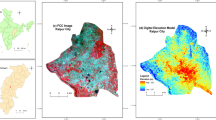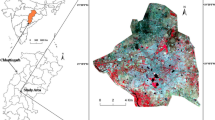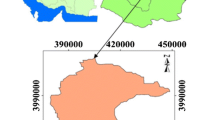Abstract
The present study aims to assess the trend of spatiotemporal relationship between land surface temperature (LST) and normalized difference vegetation index (NDVI) under different ranges of LST and NDVI values for Raipur City of India using fifteen cloud-free Landsat data sets of the pre-monsoon season from 2002 to 2018. LST maintains a strong negative relationship with NDVI for the whole of the study area. The relationship is quite insignificant for both the high LST zones and low LST zones. The results also indicate that under the positive NDVI values, the LST–NDVI relationships are strong to moderately negative, whereas it is positive and non-consistent under the negative values of NDVI. The results also show that the relationship is stronger in the earlier times, whereas it is weaker in recent times. An increase in heterogeneous landscape inside the city boundary strongly supports the changing pattern of LST–NDVI relationship.










Similar content being viewed by others
References
Bonafoni, S. (2015). Spectral index utility for summer urban heating analysis. Journal of Applied Remote Sensing, 9(1), 096030.
Chen, X.-L., Zhao, H.-M., Li, P.-X., & Yin, Z.-Y. (2006). Remote sensing image-based analysis of the relationship between urban heat island and land use/cover changes. Remote Sensing of Environment, 104, 133–146.
De Cola, L. (1989). Fractal analysis of a classified Landsat scene. Photogrammetric Engineering and Remote Sensing, 55, 601–610.
Emerson, C. W., Lam, N. S. N., & Quattrochi, D. A. (1999). Multi-scale fractal analysis of image texture and pattern. Photogrammetric Engineering and Remote Sensing, 65, 51–61.
Estoque, R. C., Murayama, Y., & Myint, S. W. (2017). Effects of landscape composition and pattern on land surface temperature: An urban heat island study in the megacities of Southeast Asia. Science of the Total Environment, 577, 349–359.
Fatemi, M., & Narangifard, M. (2019). Monitoring LULC changes and its impact on the LST and NDVI in District 1 of Shiraz City. Arabian Journal of Geosciences, 12, 127.
Ferrelli, F., Huamantinco, M. A., Delgado, D. A., & Piccolo, M. C. (2018). Spatial and temporal analysis of the LST-NDVI relationship for the study of land cover changes and their contribution to urban planning in Monte Hermoso. Argentina. Documents d’Anàlisi Geogràfica, 64(1), 25–47.
Ghobadi, Y., Pradhan, B., Shafri, H. Z. M., & Kabiri, K. (2014). Assessment of spatial relationship between land surface temperature and land use/cover retrieval from multi-temporal remote sensing data in South Karkheh Sub-basin. Iran. Arabian Journal of Geosciences, 8(1), 525–537.
Govil, H., Guha, S., Dey, A., & Gill, N. (2019). Seasonal evaluation of downscaled land surface temperature: A case study in a humid tropical city. Heliyon, 5(6), e01923.
Goward, S. N., Xue, Y. K., & Czajkowski, K. P. (2002). Evaluating land surface moisture conditions from the remotely sensed temperature/vegetation index measurements: An exploration with the simplified simple biosphere model. Remote Sensing of Environment, 79, 225–242.
Guha, S., Govil, H., Dey, A., & Gill, N. (2018). Analytical study of land surface temperature with NDVI and NDBI using Landsat 8 OLI and TIRS data in Florence and Naples city. Italy. European Journal of Remote Sensing, 51(1), 667–678.
Guha, S., Govil, H., & Diwan, P. (2019). Analytical study of seasonal variability in land surface temperature with normalized difference vegetation index, normalized difference water index, normalized difference built-up index, and normalized multiband drought index. Journal of Applied Remote Sensing, 13(2), 024518.
Guha, S., Govil, H., & Mukherjee, S. (2017). Dynamic analysis and ecological evaluation of urban heat islands in Raipur city. India. Journal of Applied Remote Sensing, 11(3), 036020.
Gutman, G., & Ignatov, A. (1998). The derivation of the green vegetation fraction from NOAA/AVHRR data for use in numerical weather prediction models. International Journal of Remote Sensing, 19(8), 1533–1543.
Hao, B., Ma, M., Li, S., Li, Q., Hao, D., Huang, J., et al. (2019). Land use change and climate variation in the three gorges reservoir catchment from 2000 to 2015 based on the Google earth engine. Sensors, 19, 2118.
Hao, X., Li, W., & Deng, H. (2016). The oasis effect and summer temperature rise in arid regions-case study in Tarim Basin. Scientific Report, 6, 35418.
Hassan, Q. K., Bourque, C. P.-A., Meng, F.-R., & Cox, R. M. (2007). A wetness index using terrain-corrected surface temperature and normalized difference vegetation index derived from standard MODIS products: An evaluation of its use in a humid forest-dominated region of Eastern Canada. Sensors, 7, 2028–2048.
Hope, A. S., & McDowell, T. P. (1992). The relationship between surface temperature and a spectral vegetation index of a tall grass prairie: Effects of burning and other landscape controls. International Journal of Remote Sensing, 13, 2849–2863.
Hou, G. L., Zhang, H. Y., Wang, Y. Q., Qiao, Z. H., & Zhang, Z. X. (2010). Retrieval and spatial distribution of land surface temperature in the middle part of Jilin Province based on MODIS data. Scientia Geographica Sinica, 30, 421–427.
Jamei, Y., Rajagopalan, P., & Sun, Q. C. (2015). Time-series dataset on land surface temperature, vegetation, built up areas and other climatic factors in top 20 global cities (2000–2018). Data Brief, 23, 103803.
Julien, Y., Sobrino, J. A., & Verhoef, W. (2006). Changes in land surface temperatures and NDVI values over Europe between 1982 and 1999. Remote Sensing of Environment, 103, 43–55.
Ke, Y. H., Im, J., Lee, J., Gong, H. L., & Ryu, Y. (2015). Characteristics of Landsat 8 Oli-derived NDVI by comparison with multiple satellite sensors and in-situ observations. Remote Sensing of Environment, 164, 298–313.
Kikon, N., Singh, P., Singh, S. K., & Vyas, A. (2016). Assessment of urban heat islands (UHI) of Noida City, India using multi-temporal satellite data. Sustainable Cities and Society, 22, 19–28.
Kumar, D., & Shekhar, S. (2015). Statistical analysis of land surface temperature–vegetation indexes relationship through thermal remote sensing. Ecotoxicology and Environmental Safety, 121, 39–44.
Lam, N. S. N. (1990). Description and measurement of Landsat TM images using fractals. Photogrammetric Engineering and Remote Sensing, 56, 187–195.
Lam, N. S. N., & De Cola, L. (1993). Fractals in geography. Englewood Cliffs, NJ: Prentice-Hall.
Lam, N. S. N., Qiu, H., Quattrochi, D. A., & Emerson, C. W. (2002). An evaluation of fractal methods for characterizing image complexity. Cartography and Geographic Information Science, 29, 25–35.
Lam, N. S. N., & Quattrochi, D. A. (1992). On the issues of scale, resolution, and fractal analysis in the mapping sciences. Professional Geographer, 44, 88–98.
Li, K., & Yu, Z. (2008). Comparative and combinative study of urban heat island in Wuhan City with remote sensing and CFD simulation. Sensors, 8, 6692–6703.
Li, W. F., Cao, Q. W., Kun, L., & Wu, J. S. (2017). Linking potential heat source and sink to urban heat island: Heterogeneous effects of landscape pattern on land surface temperature. Science of the Total Environment, 586, 457–465.
Li, Z. N., et al. (2016). Review of methods for land surface temperature derived from thermal infrared remotely sensed data. Journal of Remote Sensing, 20, 899–920.
Liu, H., & Weng, Q. (2018). Scaling effect of fused ASTER-MODIS land surface temperature in an urban environment. Sensors, 18, 4058.
Liu, K., Zhang, X., Li, X., & Jiang, H. (2014). Multiscale analysis of urban thermal characteristics: Case study of Shijiazhuang. China. Journal of Applied Remote Sensing, 8(1), 083649.
Luo, X., & Li, W. (2014). Scale effect analysis of the relationships between urban heat island and impact factors: Case study in Chongqing. Journal of Applied Remote Sensing, 8(1), 084995.
Mathew, A., Khandelwal, S., & Kaul, N. (2017). Investigating spatial and seasonal variations of urban heat island effect over Jaipur city and its relationship with vegetation, urbanization and elevation parameters. Sustainable Cities and Society, 35, 157–177.
Mathew, A., Khandelwal, S., & Kaul, N. (2018). Spatio-temporal variations of surface temperatures of Ahmedabad city and its relationship with vegetation and urbanization parameters as indicators of surface temperatures. Remote Sensing Applications: Society and Environment, 11, 119–139.
Mohammad, P., Goswami, A., & Bonafoni, S. (2019). The impact of the land cover dynamics on surface urban heat island variations in semi-arid cities: A case study in Ahmedabad City, India, using multi-sensor/source data. Sensors, 19, 3701.
Naeem, S., Cao, C., Waqar, M. M., Wei, C., & Acharya, B. K. (2018). Vegetation role in controlling the ecoenvironmental conditions for sustainable urban environments: A comparison of Beijing and Islamabad. Journal of Applied Remote Sensing, 12(1), 016013.
Nowicki, S. A., Inman, R. D., Esque, T. C., Nussear, K. E., & Edwards, C. S. (2019). Spatially consistent high-resolution land surface temperature mosaics for thermophysical mapping of the Mojave Desert. Sensors, 19, 2669.
Purevdorj, T. S., Tateishi, R., Ishiyama, T., & Honda, Y. (1998). Relationships between percent vegetation cover and vegetation indices. International Journal of Remote Sensing, 19, 3519–3535.
Qi, H., Huang, F., & Zhai, H. (2019). Monitoring spatio-temporal changes of terrestrial ecosystem soil water use efficiency in Northeast China using time series remote sensing data. Sensors, 19, 1481.
Qin, Z., Karnieli, A., & Barliner, P. (2001). A mono-window algorithm for retrieving land surface temperature from Landsat TM data and its application to the Israel-Egypt border region. International Journal of Remote Sensing, 22(18), 3719–3746.
Qiu, H. L., Lam, N. S. N., Quattrochi, D. A., & Gamon, J. A. (1999). Fractal characterization of hyperspectral imagery. Photogrammetric Engineering and Remote Sensing, 65, 63–71.
Qu, C., Ma, J. H., Xia, Y. Q., & Fei, T. (2014). Spatial distribution of land surface temperature retrieved from MODIS data in Shiyang River Basin. Arid Land Geography, 37, 125–133.
Rozenstein, O., Qin, Z., Derimian, Y., & Karnieli, A. (2014). Derivation of land surface temperature for Landsat-8 TIRS using a split window algorithm. Sensors, 14, 5768–5780.
Shi, Y., Xiang, Y., & Zhang, Y. (2019). Urban design factors influencing surface urban heat island in the high-density City of Guangzhou based on the local climate zone. Sensors, 19, 3459.
Shigeto, K. (1994). Relation between vegetation, surface temperature, and surface composition in the Tokyo region during winter. Remote Sensing of Environment, 50, 52–60.
Singh, P., Kikon, N., & Verma, P. (2017). Impact of land use change and urbanization on urban heat island in Lucknow city, Central India. A remote sensing based estimate. Sustainable Cities and Society, 32, 100–114.
Slawsky, L. M., Zhou, L., Roy, S. B., Xia, Geng, Vuille, M., & Harris, R. A. (2015). Observed thermal impacts of wind farms Over Northern Illinois. Sensors, 15, 14981–15005.
Smith, R. C. G., & Choudhury, B. J. (1990). On the correlation of indices of vegetation and surface temperature over south-eastern Australia. International Journal of Remote Sensing, 11, 2113–2120.
Stroppiana, D., Antoninetti, M., & Brivio, P. A. (2014). Seasonality of MODIS LST over Southern Italy and correlation with land cover, topography and solar radiation. European Journal of Remote Sensing, 47, 133–152.
Sun, H., Zhou, B., & Liu, H. (2019). Spatial evaluation of soil moisture (SM), land surface temperature (LST), and LST-derived sm indexes dynamics during SMAPVEX12. Sensors, 19, 1247.
Tomlinson, C. J., Chapman, L., Trones, J. E., & Baker, C. (2011). Remote sensing land surface temperature for meteorology and climatology: A review. Meteorological Applications, 18, 296–306.
Voogt, J. A., & Oke, T. R. (2003). Thermal remote sensing of urban climates. Remote Sensing of Environment, 86, 370–384.
Wen, L. J., et al. (2017). An analysis of land surface temperature (LST) and its influencing factors in summer in western Sichuan Plateau: A case study of Xichang City. Remote Sensing for Land and Resources, 29, 207–214.
Weng, Q. (2003). Fractal analysis of satellite-detected urban heat island effect. Photogrammetric Engineering and Remote Sensing, 69, 555–566.
Weng, Q. H., Lu, D. S., & Schubring, J. (2004). Estimation of land surface temperature-vegetation abundance relationship for urban heat Island studies. Remote Sensing of Environment, 89, 467–483.
Yuan, X. L. (2017). Vegetation changes and land surface feedbacks drive shifts in local temperatures over Central Asia. Scientific Report, 7, 3287.
Yue, W. Z., Hua, X. J., & Hua, X. L. (2006). An analysis on eco-environmental effect of urban land use based on remote sensing images: A case study of urban thermal environment and NDVI. Acta Ecologica Sinica, 26, 1450–1460.
Zhang, H. K., Huang, B., Zhang, M., Cao, K., & Yu, L. (2015). A generalization of spatial and temporal fusion methods for remotely sensed surface parameters. International Journal of Remote Sensing, 36(17), 4411–4445.
Zhang, J., & Wang, Y. (2008). Study of the relationships between the spatial extent of surface urban heat islands and urban characteristic factors based on Landsat ETM + Data. Sensors, 8, 7453–7468.
Zhou, Y., Shi, T. M., Hu, Y. M., & Liu, M. (2011). Relationships between land surface temperature and normalized difference vegetation index based on urban land use type. Chinese Journal of Ecology, 30, 1504–1512.
Acknowledgements
The authors were indebted to United States Geological Survey. The authors also thank the two anonymous reviewers for their beneficial comments.
Author information
Authors and Affiliations
Corresponding author
Additional information
Publisher's Note
Springer Nature remains neutral with regard to jurisdictional claims in published maps and institutional affiliations.
Rights and permissions
About this article
Cite this article
Guha, S., Govil, H. An assessment on the relationship between land surface temperature and normalized difference vegetation index. Environ Dev Sustain 23, 1944–1963 (2021). https://doi.org/10.1007/s10668-020-00657-6
Received:
Accepted:
Published:
Issue Date:
DOI: https://doi.org/10.1007/s10668-020-00657-6




